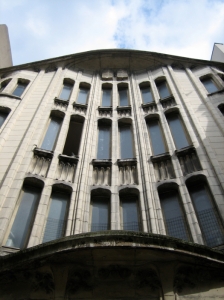When it comes to drawing a metaphorical comparison between Paris and New York City – though comparing these two cities is probably impossible -, my favorite literary image is that of Louis-Ferdinand Céline in his famous Journey to the End of the Night, describing his arrival in New York.
Figurez-vous qu’elle était debout leur ville, absolument droite. New York c’est une ville debout. On en avait déjà vu nous des villes bien sûr, et des belles encore, et des ports et des fameux même. Mais chez nous, n’est-ce pas, elles sont couchées les villes, au bord de la mer ou sur les fleuves, elles s’allongent sur le paysage, elles attendent le voyageur, tandis que celle-là l’Américaine, elle ne se pâmait pas, non, elle se tenait bien raide, là, pas baisante du tout, raide à faire peur.
Louis Ferdinad Céline, Voyage au Bout de la Nuit, 1932Just imagine, that city was standing absolutely erect. New York was a standing city. Of course we’d seen cities, fine ones too, and magnificent seaports. But in our part of the world cities lie along the seacoast or on rivers, they recline on the landscape, awaiting the traveler, while this American city had nothing languid about her, she stood there as stiff as a board, not seductive at all, terrifying still.
Journey to the End of the Night, Louis-Ferdinand Céline, Translated by Ralph Manheim, 2006
With a few aesthetically questionable exceptions such as the Eiffel and Montparnasse towers, and in its peripheral areas – like the surroundings of Place d’Italie in the XIIIe and the Front de Seine in the XVe – Paris skyline is devoid of skyscrapers.
Urban regulations, dating from Henry IV have narrowly controlled the use of materials, shape and height of Paris constructions. These rulings first aimed at preventing fires as they forbid the use of timbers and bow windows considered to be more vulnerable to flames. Height limitations obey to rules depending on the geographic situation (strict limits apply in the historical center) and the width of the street (the larger the street, the higher the building can be). 20 meters being the maximum authorised height.

Synagogue rue Pavée par Hector Guimard - 1913
Architects have had to use their imagination to find ways to express grandeur while overcoming these physical restrictions. The picture on the left shows a synagogue built by Hector Guimard in the 1910’s. Its curved facade punctuated with columns of oblong twin windows creates a sense of verticality that conjures up the spirit of Manhattan houses when seen from below. Ironically, Hector Guimard, once a leading architect of the Modern style (Art Nouveau) emigrated to New York in 1938 where he died in oblivion in 1942.
In New York, developers can freely trade air rights according to the following latin legal concept Cuius est solum, eius est usque ad caelum et ad inferos (“To whoever owns the land, shall belong the earth to its center and up to the heavens”). The only limits usually being financial.
Today, most Parisians stand against the growth of new towers in their city. Few are the Parisians proud of Tour Montparnasse. Instead, they think skyscrapers would break the harmony and stillness of the capital. In Paris, history not only infiltrates the wall, but also hearts and minds. However the current city officials have recently unearthed plans to facilitate such projects. But who knows if such plans will ever be carried out?
